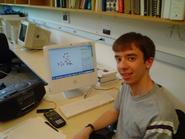
Tom Morrell '10 (Randolph, N.J.), a chemistry major, is working with Winslow Professor of Chemistry George Shields and Visiting Professor of Chemistry Thomas Castonguay to study how water clusters into small aerosol cores. Because increasing temperatures from greenhouse gases cause more water to enter the air via evaporation and this water, in turn, forms clouds that cool temperatures by reflecting sunlight, understanding how these water clusters form is an important component to studying global climate change. Building upon research he started last summer, Morrell's current project will focus on analyzing sulfuric acid and ammonium aerosol cores, which are both abundant in clouds.
Atmospheric chemists using traditional laboratory methods have only been able to look at aerosols with fifty or more water molecules. This experimental limit has left a big gap in our understanding of how aerosols initially form and how small water clusters behave. By using sophisticated molecular modeling software, Morrell is able to circumvent the experimental limit and hopes to fill in the current information gap. He starts by taking one of his aerosol cores, adding a water molecule to it, and using the computer program to examine the energetics of the reaction. Then, he adds another water molecule and starts his analysis all over again.
Morrell says he spent last summer looking at one or two water molecule aerosols, and, by the end of his this summer, he plans on working his way up to ten or more. Because his calculations involve a delicate balance between computational efficiency and accuracy, he will also be working on verifying the accuracy of his data. Ultimately, the data he collects over the summer will allow him to predict what clusters would form given a particular concentration of water, sulfuric acid, and ammonium. It may also offer insight into the dividing line separating the liquid and gas phases.
Growing progressively larger water-aerosol clusters has already yielded interesting results. Morrell is assisting Shields and Castonguay in writing two papers that will be submitted for publication. The papers will present Morrell's research findings as well as those of Marco Allodi '08. When not in the lab, Morrell plays in the orchestra and volunteers with HAVOC.
-- by Nick Berry '09
Atmospheric chemists using traditional laboratory methods have only been able to look at aerosols with fifty or more water molecules. This experimental limit has left a big gap in our understanding of how aerosols initially form and how small water clusters behave. By using sophisticated molecular modeling software, Morrell is able to circumvent the experimental limit and hopes to fill in the current information gap. He starts by taking one of his aerosol cores, adding a water molecule to it, and using the computer program to examine the energetics of the reaction. Then, he adds another water molecule and starts his analysis all over again.
Morrell says he spent last summer looking at one or two water molecule aerosols, and, by the end of his this summer, he plans on working his way up to ten or more. Because his calculations involve a delicate balance between computational efficiency and accuracy, he will also be working on verifying the accuracy of his data. Ultimately, the data he collects over the summer will allow him to predict what clusters would form given a particular concentration of water, sulfuric acid, and ammonium. It may also offer insight into the dividing line separating the liquid and gas phases.
Growing progressively larger water-aerosol clusters has already yielded interesting results. Morrell is assisting Shields and Castonguay in writing two papers that will be submitted for publication. The papers will present Morrell's research findings as well as those of Marco Allodi '08. When not in the lab, Morrell plays in the orchestra and volunteers with HAVOC.
-- by Nick Berry '09
Posted June 23, 2008
